Data extracted from John Perryman & Brett Mitchell, Australian Navy in Vietnam: Royal Australian Navy Operations 1965 – 1972, p.76-80. Reprinted with the kind permission of the Authors.
Photographs from the Australian War Memorial Collection licensed under CC BY-NC
Unit: Clearance Diving Team 3
Composition:
- LEUT R.S. Blue, RAN
- CPOCD J. F. C. Dollar
- POCD J.W. Kershler
- LSCD R.L. Steer
- LSCD J.A. Aldenhoven
- ABCD G. Kingston
- ABCD B.K. Wojcik
Deployment: March 1970 to October 1970
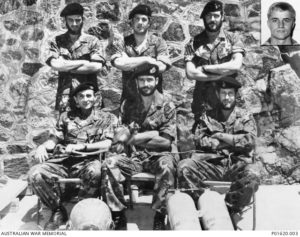
Da Nang, Vietnam, October 1970. The 7th Contingent of the Australian Navy Clearance Diving Team 3, RAN. Left to right, back row: Able seaman Clearance Diver C. (Jock) Kingston; Leading Seaman Clearance Diver J.A. (Mumbles) Aldenhoven; Leading Seaman Clearance Dirver Russ Steer. Front row: Chief Petty Officer Clearance Diver John Dollar; Lieutenant Ross Blue, and Petty Officer Clearance Diver John Kershler. The Team’s mascot, a monkey named ‘Fred’, is on Lieutenant Blue’s lap. Inserted top right is a portrait of Able Seaman B.K. (Bob) Wojcik, who was accidentally killed in a motor vehicle accident at Cam Ranh Bay, South Vietnam, on 22 June 1970. (Donor: R. Steer).
The seventh contingent’s first task involved a detachment of four of its personnel embarking in USCGC Point Banks (WPB 82327) on 22 March for passage to the Song Cau Tieu in southern Go Cong Province. Their mission was to destroy a bunker system west of Ap Hoa Bin, however, the mission did not proceed as liaison failed. The following day, the team embarked in PCF 71 and PCF 98 to investigate another bunker complex reported in the vicinity. Guided by local ‘Kit Carson Scouts’ (former VC combatants who had rallied to the South Vietnamese government under the Chieu Hoi scheme and were later employed by the FWMAF), the EOD team was inserted into the eastern and western banks of the canal. Over one dozen bunkers and structures were located and destroyed in a heavily booby-trapped area, before the team was extracted by helicopter.
Lieutenant Blue and Chief Petty Officer Dollar later returned to Go Cong Province in April where they ran a basic demolitions course for 18 South Vietnamese personnel drawn from both Regional and Popular Force Mobile Advisory Training Teams. Aided by interpreters, Blue and Dollar instructed the students in the use of C4 charges and the planning and execution of bunker search and destroy operations. On 10 April, Blue and Able Seaman Wojcik took part in a bunker operation in the eastern extremities of the Rung Sat Special Zone. However, an extensive search failed to identify their intended target, finding only a vacant VC staging camp.
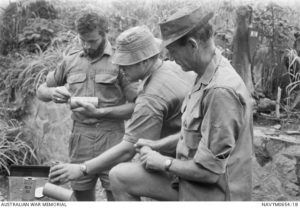
Members of the 7th Contingent, RAN Clearance Diving Team 3 (CDT3) work on the collection and disposal of bombs in Vietnam. Left to right: Able Seaman Clearance Diver (ABCD) R63109 Gerald Kingston; ABCD R93944 John Adrian Aldenhoven; and R36395 Chief Petty Officer Clearance Diver (CPOCD) John Frederick Dollar.
Returning to Vung Tau, CDT3 adopted a new mascot, a mischievous monkey christened WRAN EOD Fred. She replaced Able Seaman Blake, a large rock python. Blake had deserted the team’s quarters and was initially posted as AWOL, before being listed as ‘missing in action’. He was never seen again.
During April, team members were involved in the removal of large quantities of suspect ordnance stored in a variety of locations around Vung Tau. Of these, 870 items were destroyed and a further 1,078 identified to be dumped at sea. Of the other EOD operations undertaken in April, one unusual incident occurred on board an American merchant ship, perhaps appropriately named Keystone State. Her crew discovered a bomb among the ship’s cargo on 16 April and immediately called for assistance. CDT3 identified it as a 750lb demolition bomb and orders were given to suspend cargo operations and await their return in the morning to remove it. The team was surprised to find that when they returned to dispose of the bomb, it had unexpectedly disappeared. It was eventually tracked down to the Harbour Master’s car park, where it had been left by tug contractors. The bomb was subsequently moved to the Naval Ordnance Yard for disposal. Not long afterwards a USAF training team turned up to reclaim their ‘training aid’.
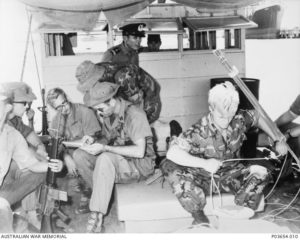
Army of the Republic of Vietnam (ARVN), USN and RAN personnel preparing equipment and planning diving and demolition operations aboard a Vietnamese patrol craft. Seated at right and unrolling detonator cord is R62713 Able Seaman Clearance Diver (ABCD) Bogdan Kaszimierz Wojcik, RAN. ABCD Wojcik was accidentally killed in a motor vehicle accident at Cam Ranh Bay, SVN, in June 1970.
The largest single undertaking by Lieutenant Blue and his men was a massive clean up at the Dong Ha combat base in Quang Tri Province, about 15 kilometres from the southern boundary of the DMZ separating North and South Vietnam. A North Vietnamese offensive in June 1968 destroyed the base Ammunition Supply Point (ASP), leaving it strewn with a huge volume of unexploded and damaged ordnance. A previous attempt to clear the site had been aborted and the area fenced off after two EOD personnel were killed and eight wounded. In early 1970, a decision was made to revisit the site and finish the job. With the task clearly beyond the capability of any one EOD team, a combined team was formed using CDT3 and personnel drawn from US Marine Crops, Army, Navy and Air Force EOD teams. The operation at Dong Ha began on 24 March and concluded on 14 May, by which time 32 EOD specialists had worked on the site. Able Seaman Wojcik was the first member of CDT3 to work at Dong Ha in late March, with the remainder of the team rotating through the site during April and May.
The EOD team divided the entire site into specific areas, through which they cleared a series of lanes, before an armoured bulldozer came in to scrape the lanes clear and form roads. The EOD personnel swept the adjacent areas, removed the live ordnance and placed in it stacks on the road. The stacks were then transported to a designated demolition area for disposal. Unstable ordnance deemed unsafe for transportation was carried by hand to a cleared area and destroyed in situ.
As well as facing the hazards associated with handling unusually large quantities of explosive ordnance, personnel had to combat fatigue brought on by temperatures exceeding 40 degrees Celsius. This was further compounded by a safety requirement to wear flak jackets and steel helmets. More alarming, was the fact they were endangered by ARVN soldiers stationed at the Dong Ha base, who for unexplained reasons fired sporadically at the EOD team. This twice brought operations to a complete halt, forcing personnel to take cover. On other occasions the ARVN troops stole equipment and scattered stacks of ammunition in their search for usable rounds. These incidents were reported to the senior ARVN adviser, but little changed.
The operation was successfully completed without any casualties. Approximately 90 acres were cleared and 1,025 tons of ordnance was recovered and destroyed. This included over 40,000 Improved Conventional Munitions (ICM) rounds, predominantly 155mm and 8-inch howitzer rounds. Another 1,678 rounds of 8-inch high explosive rounds were salvaged for future use on the battlefield, and a similar volume of 155 mm and 8-inch rounds recovered for later disposal at sea. As a USMC officer recalled: ‘The only parallel environment that the Dong Ha Ammunition Supply Point can be likened to would be an anti-personnel minefield. For example, in one storage cell of approximately 40 metre by 40 metre dimensions, over 5,000 ICM sub-missiles were recovered’. Each member of CDT3 deservedly received the US Army Commendation Medal.
In May, team members were active in the Iron Triangle north of Phu Cuong, and in the Rung Sat Special Zone. The Iron Triangle was an area well known for its rabbit warren of VC tunnel complexes. Two Australians were detached for an operation with a Vietnamese Navy EOD team, supported by river patrol boats and Popular Force troops. On this occasion, inaccurate intelligence led to only two bunkers and one tunnel being destroyed. Two detainees were also brought in for interrogation.
On 20 May, Petty Officer Kershler deployed from Nha Be with a combined force, including Regional Force troops, embarked in four Alpha boats (Assault Support Patrol Boats) for operations in the Rung Sat. After first establishing a base camp, the Regional Force located an enemy camp, killing six VC in the ensuing engagement, but losing five of their own men. Air strikes were called in that evening and the EOD team was inserted over the next two days, destroying seven bunkers. Chief Petty Officer Dollar participated in a further sweep through the district of Can Gio with the Nha Be EOD team on 27 and 28 May. Contact was made with enemy forces on several occasions, during which fifteen VC and five Regional Force troops were killed.
CDT3 personnel continued to complement other units throughout June. Able Seaman Kingston joined two USN EOD technicians and five salvage divers from Harbour Clearance Unit one on 15 June, and proceeded to Thoi Binh on the Song Ong Doc. Here they demolished a sunken Tango boat (Armoured Troop Carrier). Leading Seaman Steer was attached to EODMUPAC Team 39 on board YRBM-21 stationed on the Mekong River near the Cambodian border. The previous month allied forces had crossed the border into Cambodia on Operation TRAN HUNG DAO XI, which aimed to secure the Mekong River from the border to Phnom Penh and evacuate refugees as required.
Able Seaman Wojcik was working with EODMUPAC Team 32 at Cam Ranh Bay on 21 June 1970 when a jeep in which he was a passenger failed to negotiate a sharp turn. The 23-year old Wojcik sustained fatal injuries and was pronounced dead on arrival at the local USAF hospital. Petty Officer Kershler was immediately despatched to Cam Ranh Bay to attend to post-accident proceedings. Chief Petty Officer Dollar and Leading Seaman Steer accompanied Able Seaman Wojcik’s body back to Australia and attended his funeral service.
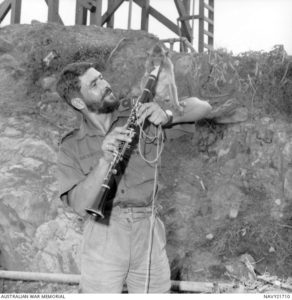
The RAN fleet band made a musical tour of Australian bases in South Vietnam. At the RAN Clearance Diving Team 3 (CDT3) base at Vung Tau, South Vietnam, Fred the monkey mascot tries his hand at music with the help of Lieutenant Ross Sinclair Blue, of North Cottesloe, WA.
In the early hours of 28 June Lieutenant Blue, Petty Officer Kershler and Able Seaman Kingston responded to a call from USS Meeker County (LST 980) berthed alongside the De Long Pier, Vung Tau. A watchful sentry on the LST had sighted a nylon line secured to a pier fender and a swimmer in the same area. Kershler entered the water and removed a black package slung from a cord which led from the pier near the ship’s starboard bow to the port rudder post. The package was first towed clear by a PBR. Blue then commandeered a skimmer and towed it 1,000 metres to an empty barge, to which he attached the suspect package to a securing line and marked it with a buoy. Blue planned to move the package to a nearby mud bank in the morning with a view to examining it more closely, but at 0715 it detonated. Further searches in the vicinity of Meeker County by Kingston found the snorkel believed to have been used by the enemy sapper.
The team returned to full strength in July 1970 with Leading Seaman John Aldenhoven replacing Wojcik. Throughout the month, the team cleared almost 7,000 items of ordnance from the Naval Ordnance yard, which were then transported by LST to nearby Long Son Island and detonated in a single explosion. On 16 July, a 500 lb bomb was rendered safe before being winched off the mud flats opposite Bin Dinh village by a RAAF 9 Squadron helicopter.
By the end of the month the team’s STABLEDOOR area of responsibility was extended to included the inner harbour, ostensibly due to a country wide increase in enemy swimmer activity. This was a timely development in light of the recent incident involving USS Meeker County, however, it did not deter one enterprising VC operative who succeeded in detonating an explosive charge alongside the tug Michael at De Long Pier on 12 August. The tug’s hull remained intact, but the internal damage was extensive. A sizable crater in the harbour floor suggested that the sapper failed to properly secure the charge to the hull.
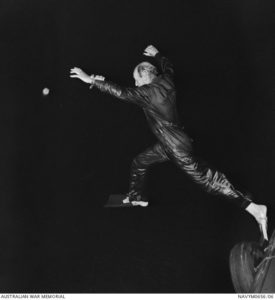
An unidentified member of the 7th Contingent, RAN Clearance Diving Team 3 (CDT3) jumps into the water during a search of a ship’s cable for explosives. CDT3 was primarily involved in clearing rivers and shipping channels of mines and booby traps laid by the Viet Cong. They carried out underwater searches on allied shipping, salvage work, and disposal of unstable ammunition.
On 8 July, three team members joined Coastal Group 34 on the Song Ham Loung. The following morning, a force of three junks, one skimmer, eight Vietnamese Navy personnel and advisers, departed on a sweeping operation through a known VC bunker complex. The three Australians successfully cleared booby-traps, searched the complex and then destroyed it. There was no enemy contact, but signs of recent occupation were evident. Eight bunkers were destroyed along with other structures, sampans, grenade traps, cooking gear, food and clothing.
On 26 July, another three-man team, embarked in USCGC Point Cypress (WPB 82331) near Long Phu. Operating with two companies of Regional Force troops and their advisers, the ships entered the Song My Thanh and proceeded up the river to a designated point where the troops and divers were landed. During the next three hours 24 bunkers were destroyed along the river bank. Numerous booby-traps were encountered throughout the operation, many of which were bypassed. The following day CDT3 personnel and five SEALS set out in three skimmers for Dung Island to destroy a log barricade. Point Cypress and Point Marone blocked the southern entrance of the target canal while the skimmers entered from the north. Two log barricades were encountered and destroyed using Mk8 hose charges. The previous CDT3 contingent had earlier destroyed several barricades in the same canal. The team returned to Vung Tau that afternoon, thus drawing to a close CDT3’s final foray into the Mekong Delta.
Preparations were now in full swing for the team’s impending relocation to Da Nang. On 14 August 1970, in keeping with the program of ‘Vietnamisation’, CDT3 was relieved of its STABLEDOOR duties by two Vietnamese Navy EOD teams. The following morning, two USAF C-130 aircraft airlifted the team to Da Nang. Before leaving the team stripped back the ‘cave’ to its original condition and presented the building materials to the RAAF Chaplain for use at a local orphanage.
In Da Nang the team was accommodated at Camp Tien Sha at the foot of the southern slopes of the Tien Sha Peninsula. Responsibility for all naval EOD operations in Military Region 1 now rested with CDT3 and Vietnamese Navy EOD reams 82/02 and 82/04. Operations in Military Region 1 extended north to the DMZ, where Leading Seaman Steer was among the first to be attached to a Vietnamese EOD team on the Cua Viet.
Requests for EOD assistance at Da Nang were generally similar to those experienced at Vung Tau, involving the rendering safe and destruction of unstable ordnance. Lieutenant Blue and Able Seaman Kingston defused a 250lb bomb in Xuyen Long, Chief Petty Officer Dollar led a team to Hoi An to sweep an area prior to land clearing operations, and team members removed anti-personnel mines from the Coastal Group 13 base at the entrance of the Song Cua Dai.
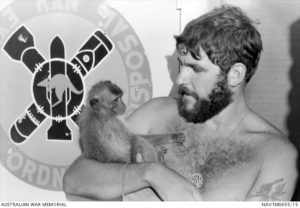
Leading Seaman Clearance Diver (LSCD) Russell Leonard Steer, of the 7th Contingent, RAN Clearance Diving Team 3 (CDT3) relaxing while off duty at a base, probably in Vung Tau, South Vietnam. LSCD Steer is holding the team’s pet monkey, probably Fred, their mascot.
On 31 August, CDT3 conducted its first operation with a USN Jungle Surveillance Team on Cam Thanh Island, east of Hoi An. The Jungle Surveillance Team’s primary objective was to implant chains of audio sensors in areas suspected or expected to harbour the enemy. Despite the prevalence of booby-traps, team members destroyed enemy bunkers and rigged demolition charges and claymore mines, which were connected to the sensors. Monitors in Hoi An could then trigger ambushes remotely whenever they detected enemy activity. During the first operation, the accompanying security force was engaged in a firefight with enemy forces, and assault helicopters and fighter aircraft were instrumental in forcing the enemy to withdraw, allowing the EOD team (Petty Officer Kershler and Leading Seaman Aldenhoven) to move in and set up their ambush.
Over the next seven weeks CDT3 gave EOD support to another eight Jungle Surveillance Group operations until the task became ‘Vietnamised’. On 18 October, Chief Petty Officer Dollar and Leading Seaman Aldenhoven took two members of the newly arrived Australian relief team, Chief Petty Officer Gilchrist and Able Seaman Furner, on their final operation to Cam Thanh Island. It was during this operation that Aldenhoven performed an extraordinary act of bravery, for which he was decorated with the Distinguished Service Medal for ‘personal courage of the highest order’. After destroying two booby-traps and one bunker, his group moved inland where they encountered another bunker. Here an American sailor trod on a booby-trapped 105mm shell, killing himself and wounding two Vietnamese soldiers. The group came under heavy enemy fire which pinned them down and prevented any attempt to extract or evacuate the wounded. Subsequent events are best described by Aldenhoven’s citation which reads ‘with complete disregard for his own safety and under fire from three sides, Leading Seaman Aldenhoven first assisted the wounded to cover, and then returned three times across fifty metres of open ground to recover weapons and ammunition which would have otherwise fallen into enemy hands’. Helicopter gunships arrived two hours later, enabling the force to extract. This concluded the seventh contingent’s operational tour of duty.

